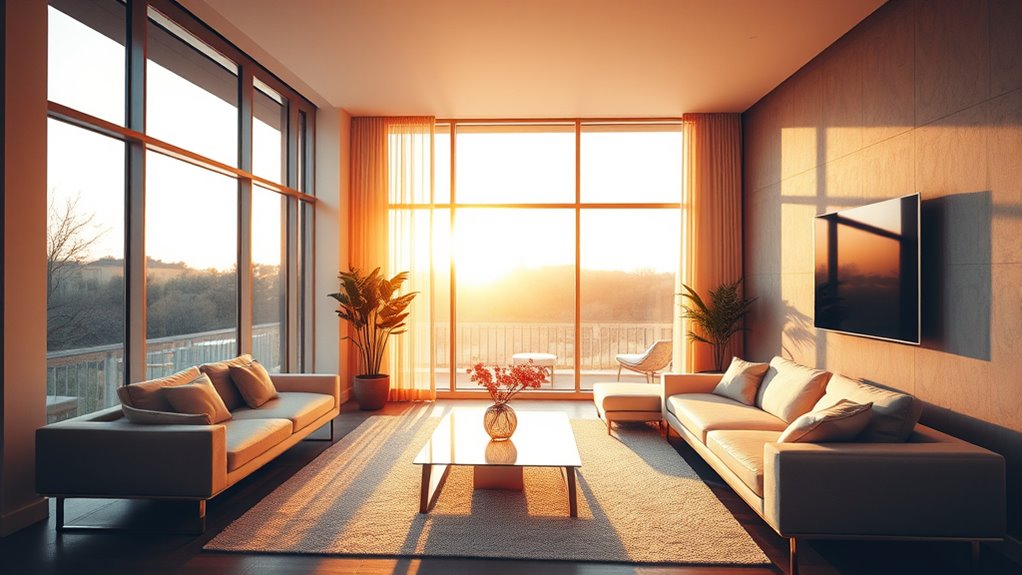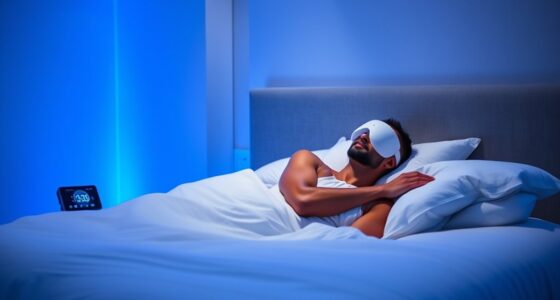To design homes that match your biological clock, you should use lighting that mimics natural light patterns. Bright, blue-enriched light in the morning helps boost your energy, while warmer, softer lighting in the evening signals your body to wind down. Adjusting your home’s lighting with smart fixtures or dimmers supports your circadian rhythm, improving sleep and overall health. Keep exploring to learn how to optimize your home environment for better daily functioning.
Key Takeaways
- Use adjustable lighting to mimic natural daylight cycles, with bright, blue-enriched light during the day and warmer, dimmer light in the evening.
- Incorporate smart lighting systems that allow customization of brightness and hue to align with your circadian rhythm.
- Minimize blue light exposure from screens at least one hour before bedtime to support melatonin production and sleep quality.
- Design home lighting that gradually shifts from cool, energizing tones in the morning to warm, relaxing tones at night.
- Consistently matching indoor lighting to natural patterns enhances sleep, boosts energy, and promotes overall well-being.

Have you ever wondered how light influences your daily energy and sleep patterns? It’s a fascinating connection that plays a essential role in how you feel and function each day. Your body’s internal clock, or circadian rhythm, is sensitive to light cues, which helps regulate your sleep-wake cycle, hormone production, and overall alertness. When your environment aligns with this biological rhythm, you notice improvements in sleep quality and energy levels. Conversely, inconsistent or inadequate lighting can throw your internal clock off balance, leading to fatigue, difficulty concentrating, and restless nights.
Designing your home with circadian lighting in mind means creating a space that mimics natural light patterns. During the day, bright, blue-enriched light stimulates your eyes, signaling your brain to stay alert and active. This boost in light exposure enhances your mood and cognitive function, making it easier to focus on tasks and stay energized. As the day progresses and evening approaches, the lighting should gradually shift to warmer, dimmer tones. This changeover helps your body produce melatonin, the hormone responsible for making you feel sleepy. When your home lighting aligns with these natural cues, it supports your body’s ability to wind down effectively, improving sleep quality.
You can start by incorporating adjustable lighting fixtures that mimic the changing intensity and color temperature of daylight. Smart bulbs or lighting systems give you the flexibility to tailor your environment’s brightness and hue throughout the day. In the morning, turn on cooler, brighter lights to kickstart your energy levels. As evening nears, switch to warmer, softer lighting that signals your body to prepare for rest. This consistency reinforces your circadian rhythm, making it easier to fall asleep and wake up feeling refreshed. Additionally, understanding the impact of light on health can help you make more informed choices about your lighting environment.
Furthermore, reducing exposure to blue light from screens at least an hour before bedtime complements your circadian lighting setup. This helps prevent disruption of melatonin production, ensuring your sleep quality remains high. By paying attention to the lighting environment you create at home, you’re actively supporting your body’s natural cycles. Over time, this alignment can lead to sustained improvements in how rested and energized you feel each day.
Ultimately, designing homes that match your biological clock isn’t just about aesthetics; it’s about fostering a healthier, more balanced lifestyle. When your environment supports your circadian rhythm, you experience better sleep, increased energy levels during the day, and an overall sense of well-being. It’s a simple yet powerful way to optimize your daily routine and enjoy the benefits of natural harmony between your home and your body.
Frequently Asked Questions
How Does Circadian Lighting Affect Sleep Quality?
Circadian lighting considerably improves your sleep quality by supporting melatonin regulation and maintaining your circadian rhythm. When your home lighting mimics natural light patterns, it helps your body recognize day and night, making it easier to fall asleep and wake up refreshed. Proper lighting cues your brain to produce melatonin at the right times, ensuring your circadian rhythm stays synchronized. This results in deeper, more restorative sleep and better overall health.
Can Circadian Lighting Reduce Energy Costs?
Coincidentally, circadian lighting can considerably reduce your energy costs. By adjusting light intensities and timing to match natural daylight, you use less electricity during off-peak hours, boosting energy savings. This approach enhances cost efficiency by optimizing lighting use, preventing unnecessary power consumption. When you adopt circadian lighting, you not only support your health but also enjoy lower utility bills, making your home more sustainable and economical.
What Are the Best Lighting Colors for Morning?
For a fresh morning ambiance, you should choose lighting with a color temperature between 5000K and 6500K. These cooler tones mimic natural daylight, helping you wake up and feel alert. Bright, bluish-white light enhances your morning routine by boosting energy and mood. To start your day right, opt for lighting that creates an invigorating atmosphere, making your mornings more productive and pleasant.
Is Circadian Lighting Suitable for People With Sleep Disorders?
If you have sleep disorders, personalized lighting can be helpful for sleep disorder management. Circadian lighting adjusts your home’s light exposure to support your natural sleep-wake cycle, potentially improving sleep quality. It’s suitable because it mimics natural light patterns, helping regulate your internal clock. You should consider it as part of a broader approach, but always consult a healthcare professional for tailored advice on managing your sleep issues.
How Quickly Can I See Benefits From Installing Circadian Lighting?
You might notice improvements in your sleep and mood within a few days after lighting installation, but it varies based on your user experience and routine. Consistent exposure to well-designed circadian lighting helps reset your internal clock faster. Keep in mind, some people see quicker benefits, while others may take weeks. Patience and regular use are key to experiencing the full positive effects of circadian lighting.
Conclusion
By now, you see how circadian lighting can transform your home into a space that works with your natural rhythm. When you align your environment with your biological clock, you’ll feel more energized and rested. Remember, “The early bird catches the worm,” so start adapting your lighting today and enjoy the benefits of a healthier, more balanced life. Embrace these changes, and watch your days become brighter—literally and figuratively.










